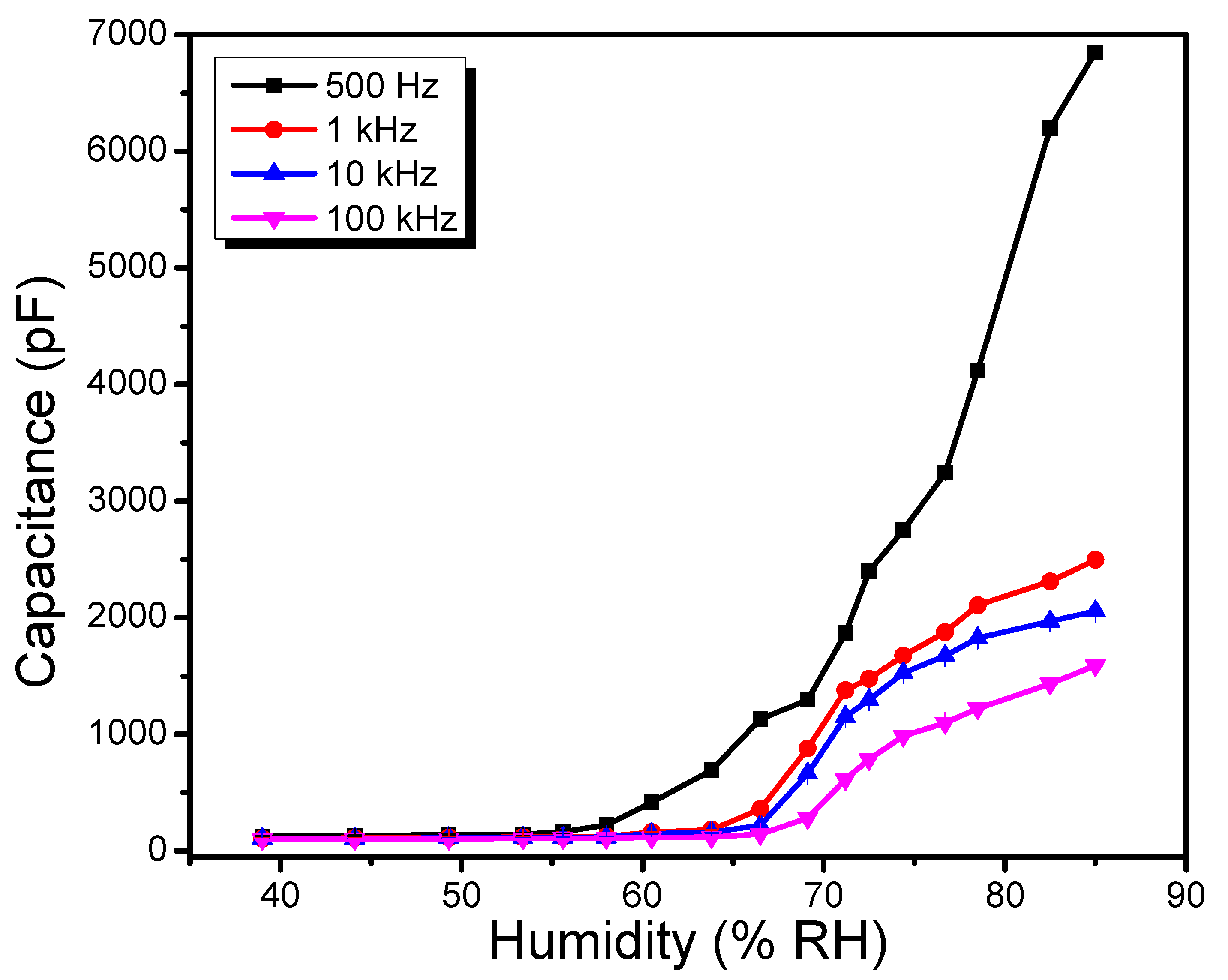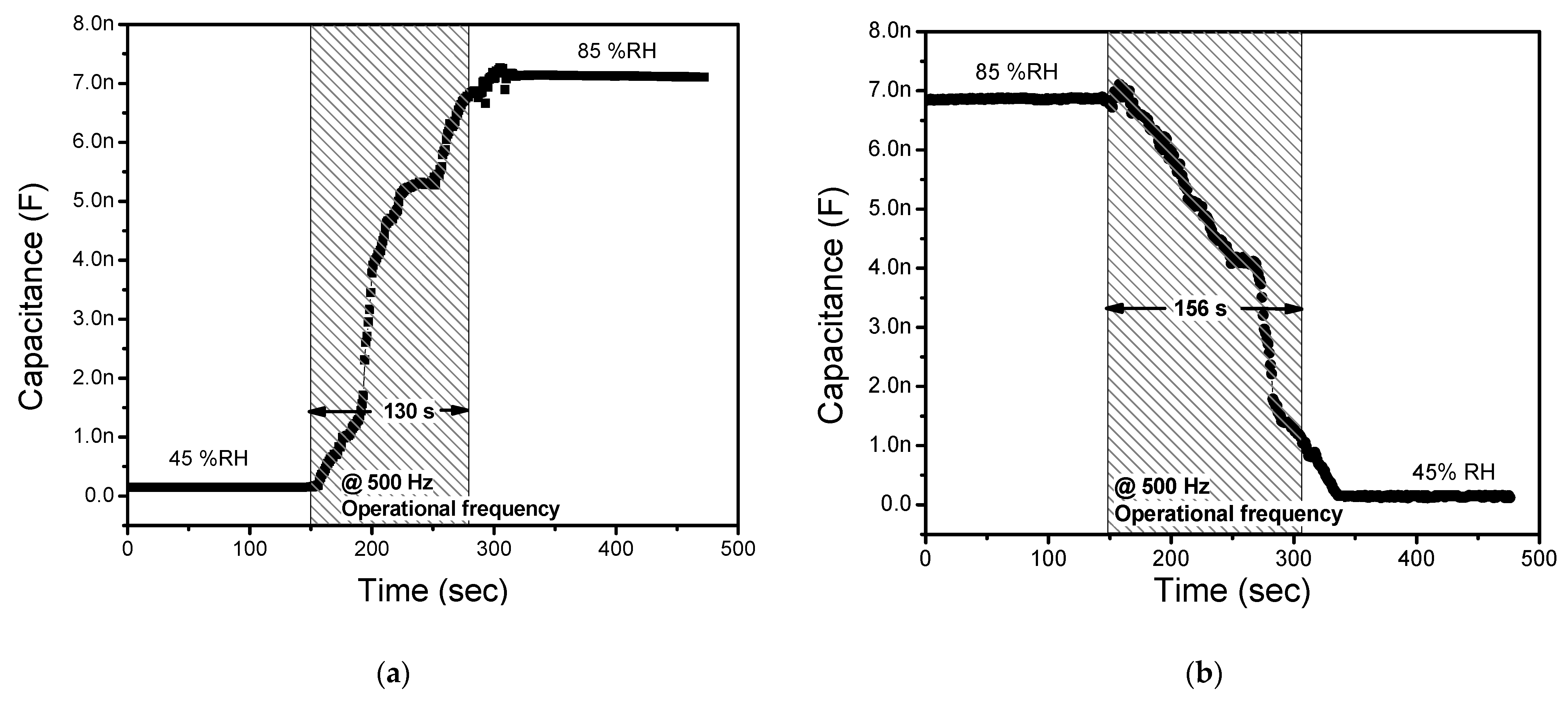Capacitive and Conductometric Type Dual-Mode Relative Humidity Sensor Based on 5,10,15,20-tetra Phenyl Porphyrinato Nickel (II) (TPPNi)
Abstract
:1. Introduction
2. Materials and Methods
2.1. Synthesis of TPPNi
2.2. Fabrication of Humidity Sensor
2.3. Sensor Testing Methodology
3. Results and Discussion
3.1. Physical Characterization of TPPNi Active Layer
3.2. Electrical Characterization of Humidity Sensor
4. Conclusions
Author Contributions
Funding
Institutional Review Board Statement
Informed Consent Statement
Data Availability Statement
Acknowledgments
Conflicts of Interest
References
- Zetola, N.M.; Modongo, C.; Matlhagela, K.; Sepako, E.; Matsiri, O.; Tamuhla, T.; Mbongwe, B.; Martinelli, E.; Sirugo, G.; Paolesse, R. Identification of a large pool of microorganisms with an array of porphyrin based gas sensors. Sensors 2016, 16, 466. [Google Scholar] [CrossRef] [Green Version]
- Wang, Y.-F.; Sekine, T.; Takeda, Y.; Yokosawa, K.; Matsui, H.; Kumaki, D.; Shiba, T.; Nishikawa, T.; Tokito, S. Fully printed PEDOT: PSS-based temperature sensor with high humidity stability for wireless healthcare monitoring. Sci. Rep. 2020, 10, 2467. [Google Scholar] [CrossRef] [Green Version]
- Sharma, A.K.; Kaur, B.; Popescu, V.A. On the role of different 2D materials/heterostructures in fiber-optic SPR humidity sensor in visible spectral region. Opt. Mater. 2020, 102, 109824. [Google Scholar] [CrossRef]
- Lou, C.; Hou, K.; Zhu, W.; Wang, X.; Yang, X.; Dong, R.; Chen, H.; Guo, L.; Liu, X. Human Respiratory Monitoring Based on Schottky Resistance Humidity Sensors. Materials 2020, 13, 430. [Google Scholar] [CrossRef] [PubMed] [Green Version]
- Kundu, S.; Majumder, R.; Ghosh, R.; Pradhan, M.; Roy, S.; Singha, P.; Ghosh, D.; Banerjee, A.; Banerjee, D.; Chowdhury, M.P. Relative humidity sensing properties of doped polyaniline-encased multiwall carbon nanotubes: Wearable and flexible human respiration monitoring application. J. Mater. Sci. 2020, 55, 3884–3901. [Google Scholar] [CrossRef]
- Wang, Y.; Zhang, L.; Zhang, Z.; Sun, P.; Chen, H. High-Sensitivity Wearable and Flexible Humidity Sensor Based on Graphene Oxide/Non-Woven Fabric for Respiration Monitoring. Langmuir 2020, 36, 9443–9448. [Google Scholar] [CrossRef] [PubMed]
- Olu, A.A.; Adefolarin, O.A. Internet of Things Based Data Logger System for Temperature and Humidity Monitoring Using Microcontroller. J. Eng. Appl. Sci. Res. 2019, 11, 35–48. [Google Scholar]
- Lee, C.-Y.; Lee, G.-B. Humidity sensors: A review. Sens. Lett. 2005, 3, 1–15. [Google Scholar] [CrossRef]
- Blank, T.; Eksperiandova, L.; Belikov, K. Recent trends of ceramic humidity sensors development: A review. Sensor Actuat. B 2016, 228, 416–442. [Google Scholar] [CrossRef]
- Farahani, H.; Wagiran, R.; Hamidon, M.N. Humidity sensors principle, mechanism, and fabrication technologies: A comprehensive review. Sensors 2014, 14, 7881–7939. [Google Scholar] [CrossRef] [Green Version]
- Najeeb, M.A.; Ahmad, Z.; Shakoor, R.A. Organic thin-film capacitive and resistive humidity sensors: A focus review. Adv. Mater. Interfaces 2018, 5, 1800969. [Google Scholar] [CrossRef]
- Ramanavicius, S.; Ramanavicius, A. Conducting Polymers in the Design of Biosensors and Biofuel Cells. Polymers 2021, 13, 49. [Google Scholar] [CrossRef]
- Ramanavicius, S.; Ramanavicius, A. Charge Transfer and Biocompatibility Aspects in Conducting Polymer-Based Enzymatic Biosensors and Biofuel Cells. Nanomaterials 2021, 11, 371. [Google Scholar] [CrossRef]
- Ramanavicius, S.; Ramanavicius, A. Insights in the Application of Stoichiometric and Non-Stoichiometric Titanium Oxides for the Design of Sensors for the Determination of Gases and VOCs (TiO2−x and TinO2n−1 vs. TiO2). Sensors 2020, 20, 6833. [Google Scholar] [CrossRef] [PubMed]
- Ramanavicius, S.; Tereshchenko, A.; Karpicz, R.; Ratautaite, V.; Bubniene, U.; Maneikis, A.; Jagminas, A.; Ramanavicius, A. TiO2−x/TiO2-Structure Based ‘Self-Heated’ Sensor for the Determination of Some Reducing Gases. Sensors 2020, 20, 74. [Google Scholar] [CrossRef] [PubMed] [Green Version]
- Alharthy, R.D.; Saleh, A. A Novel Trace-Level Ammonia Gas Sensing Based on Flexible PAni-CoFe2O4 Nanocomposite Film at Room Temperature. Polymers 2021, 13, 3077. [Google Scholar] [CrossRef]
- Mahapatra, S.D.; Mohapatra, P.C.; Aria, A.I.; Christie, G.; Mishra, Y.K.; Hofmann, S.; Thakur, V.K. Piezoelectric Materials for Energy Harvesting and Sensing Applications: Roadmap for Future Smart Materials. Adv. Sci. 2021, 8, 2100864. [Google Scholar] [CrossRef]
- Harsányi, G. Polymer films in sensor applications: A review of present uses and future possibilities. Sens. Rev. 2000, 20, 98–105. [Google Scholar] [CrossRef]
- Sulaiman, K.; Ahmad, Z.; Fakir, M.S.; Abd Wahab, F.; Mah Abdullah, S.; Abdul Rahman, Z. Organic Semiconductors: Applications in Solar Photovoltaic and Sensor Devices. In Materials Science Forum; Trans Tech Publications: Stafa-Zurich, Switzerland, 2013; pp. 126–132. [Google Scholar]
- Wang, S.; Kang, Y.; Wang, L.; Zhang, H.; Wang, Y.; Wang, Y. Organic/inorganic hybrid sensors: A review. Sens. Actuators B 2013, 182, 467–481. [Google Scholar] [CrossRef]
- Spadavecchia, J.; Ciccarella, G.; Siciliano, P.; Capone, S.; Rella, R. Spin-coated thin films of metal porphyrin–phthalocyanine blend for an optochemical sensor of alcohol vapours. Sens. Actuators B 2004, 100, 88–93. [Google Scholar] [CrossRef]
- Wang, L.; Li, H.; Deng, J.; Cao, D. Recent advances in porphyrin-derived sensors. Curr. Org. Chem. 2013, 17, 3078–3091. [Google Scholar] [CrossRef]
- Sekrafi, T.; Denden, Z.; Tudorache, F.; Tascu, S.; Nasri, H.; Dridi, C. ZnTTP electrical properties and application in humidity sensor development. Superlattices Microstruct. 2020, 140, 106462. [Google Scholar] [CrossRef]
- Yaseen, M.; Ali, M.; NajeebUllah, M.; Ali Munawar, M.; Khokhar, I. Microwave-assisted synthesis, metallation, and duff formylation of porphyrins. J. Heterocycl. Chem. 2009, 46, 251–255. [Google Scholar] [CrossRef]
- Bajju, G.D.; Ahmed, A.; Gupta, D.; Kapahi, A.; Devi, G. Synthesis and spectroscopic characterization of some new axially ligated indium (III) macrocyclic complexes and their biological activities. Bioinorg. Chem. Appl. 2014, 2014, 865407. [Google Scholar] [CrossRef] [PubMed] [Green Version]
- Humphrey, J.L.; Kuciauskas, D. Contrasting Fe (III) tetrakis (4-hydroxyphenyl) porphyrin excited state dynamics in solution and solid states. J. Phys. Chem. C 2008, 112, 1700–1704. [Google Scholar] [CrossRef]
- Dolci, L.S.; Marzocchi, E.; Montalti, M.; Prodi, L.; Monti, D.; Di Natale, C.; D’Amico, A.; Paolesse, R. Amphiphilic porphyrin film on glass as a simple and selective solid-state chemosensor for aqueous Hg2+. Biosens. Bioelectron. 2006, 22, 399–404. [Google Scholar] [CrossRef]
- de Sales, N.F.; Mansur, H.S. Chemsensor of NO2 gas based on porphyrin of 5, 10, 15, 20-tetraphenylporphyrin LB films and LS films. Mater. Res. 2008, 11, 477–482. [Google Scholar] [CrossRef] [Green Version]
- Bates, S.; Zografi, G.; Engers, D.; Morris, K.; Crowley, K.; Newman, A. Analysis of amorphous and nanocrystalline solids from their X-ray diffraction patterns. Pharm. Res. 2006, 23, 2333–2349. [Google Scholar] [CrossRef]
- Słota, R.; Broda, M.A.; Dyrda, G.; Ejsmont, K.; Mele, G. Structural and molecular characterization of meso-substituted zinc porphyrins: A DFT supported study. Molecules 2011, 16, 9957–9971. [Google Scholar] [CrossRef] [Green Version]
- Li, L.; Liu, R.; Xu, Z.; Xu, Y.; Wang, W.; Fan, C. Distorted surface topography observed by atomic force microscopy. Measurement 2006, 39, 12–15. [Google Scholar] [CrossRef]
- Yang, H.; Wang, Y.; Lai, S.; An, H.; Li, Y.; Chen, F. Application of atomic force microscopy as a nanotechnology tool in food science. J. Food Sci. 2007, 72, R65–R75. [Google Scholar] [CrossRef]
- Sharifi-Viand, A.; Mahjani, M.G.; Jafarian, M. Determination of fractal rough surface of polypyrrole film: AFM and electrochemical analysis. Synth. Met. 2014, 191, 104–112. [Google Scholar] [CrossRef]
- Szuber, J.; Uljanow, J.; Karczewska-Buczek, T.; Jakubik, W.; Waczyński, K.; Kwoka, M.; Kończak, S. On the correlation between morphology and gas sensing properties of RGTO SnO2 thin films. Thin Solid Films 2005, 490, 54–58. [Google Scholar] [CrossRef]
- Sikarwar, S.; Yadav, B. Opto-electronic humidity sensor: A review. Sens. Actuators A Phys. 2015, 233, 54–70. [Google Scholar] [CrossRef]
- Ahmad, Z.; Zafar, Q.; Sulaiman, K.; Akram, R.; Karimov, K.S. A humidity sensing organic-inorganic composite for environmental monitoring. Sensors 2013, 13, 3615–3624. [Google Scholar] [CrossRef] [PubMed] [Green Version]
- De Podesta, M. Understanding the Properties of Matter; CRC Press: Boca Raton, FL, USA, 2020. [Google Scholar]
- Ishihara, T.; Matsubara, S. Capacitive type gas sensors. J. Electroceram. 1998, 2, 215–228. [Google Scholar] [CrossRef]
- Dunn, A. The dielectric constants of argon, carbon dioxide, nitrogen, and oxygen determined at an audio frequency. Can. J. Phys. 1964, 42, 1489–1498. [Google Scholar] [CrossRef]
- Abdulameer, A.F.; Suhail, M.H.; Abdullah, O.G.; Al-Essa, I.M. Fabrication and characterization of NiPcTs organic semiconductors based surface type capacitive–resistive humidity sensors. J. Mater. Sci. Mater. Electron. 2017, 28, 13472–13477. [Google Scholar] [CrossRef]
- Shah, M.; Ahmad, Z.; Sulaiman, K.; Karimov, K.S.; Sayyad, M. Carbon nanotubes’ nanocomposite in humidity sensors. Solid-State Electron. 2012, 69, 18–21. [Google Scholar] [CrossRef]
- Rittersma, Z. Recent achievements in miniaturised humidity sensors—A review of transduction techniques. Sens. Actuators A Phys. 2002, 96, 196–210. [Google Scholar] [CrossRef]
- Morris, J.E.; Iniewski, K. Nanoelectronic Device Applications Handbook; CRC Press: Boca Raton, FL, USA, 2013. [Google Scholar]
- Karimov, K.S.; Saleem, M.; Karieva, Z.; Mateen, A.; Chani, M.T.S.; Zafar, Q. Humidity sensing properties of Cu2O-PEPC nanocomposite films. J. Semicond. 2012, 33, 073001. [Google Scholar] [CrossRef]
- Jiang, W.; Xiao, S.; Zhang, H.; Dong, Y.; Li, X. Capacitive humidity sensing properties of carbon nanotubes grown on silicon nanoporous pillar array. Sci. China Ser. E Technol. Sci. 2007, 50, 510–515. [Google Scholar] [CrossRef]
- Pinotti, E.; Sassella, A.; Borghesi, A.; Paolesse, R. Characterization of organic semiconductors by a large-signal capacitance–voltage method at high and low frequencies. Synth. Met. 2003, 138, 15–19. [Google Scholar] [CrossRef]
- Wang, Y.; Park, S.; Yeow, J.T.; Langner, A.; Müller, F. A capacitive humidity sensor based on ordered macroporous silicon with thin film surface coating. Sens. Actuators B Chem. 2010, 149, 136–142. [Google Scholar] [CrossRef]
- Li, D.; Zhang, J.; Shen, L.; Dong, W.; Feng, C.; Liu, C.; Ruan, S. Humidity sensing properties of SrTiO3 nanospheres with high sensitivity and rapid response. RSC Adv. 2015, 5, 22879–22883. [Google Scholar] [CrossRef]
- Faia, P.; Furtado, C.; Ferreira, A. Humidity sensing properties of a thick-film titania prepared by a slow spinning process. Sens. Actuators B Chem. 2004, 101, 183–190. [Google Scholar] [CrossRef]
- Bi, H.; Yin, K.; Xie, X.; Ji, J.; Wan, S.; Sun, L.; Terrones, M.; Dresselhaus, M.S. Ultrahigh humidity sensitivity of graphene oxide. Sci. Rep. 2013, 3, 2714. [Google Scholar] [CrossRef] [Green Version]
- Chen, Z.; Lu, C. Humidity sensors: A review of materials and mechanisms. Sens. Lett. 2005, 3, 274–295. [Google Scholar] [CrossRef] [Green Version]
- Agarwal, S.; Sharma, G. Humidity sensing properties of (Ba, Sr) TiO3 thin films grown by hydrothermal–electrochemical method. Sens. Actuators B Chem. 2002, 85, 205–211. [Google Scholar] [CrossRef]
- Geng, W.; Li, N.; Li, X.; Wang, R.; Tu, J.; Zhang, T. Effect of polymerization time on the humidity sensing properties of polypyrrole. Sens. Actuators B Chem. 2007, 125, 114–119. [Google Scholar] [CrossRef]
- Parthibavarman, M.; Hariharan, V.; Sekar, C. High-sensitivity humidity sensor based on SnO2 nanoparticles synthesized by microwave irradiation method. Mater. Sci. Eng. C 2011, 31, 840–844. [Google Scholar] [CrossRef]
- Azmer, M.I.; Ahmad, Z.; Sulaiman, K.; Al-Sehemi, A.G. Humidity dependent electrical properties of an organic material DMBHPET. Measurement 2015, 61, 180–184. [Google Scholar] [CrossRef]
- Choi, K.S.; Kim, D.S.; Yang, H.J.; Ryu, M.S.; Chang, S.P. A highly sensitive humidity sensor with a novel hole array structure using a polyimide sensing layer. RSC Adv. 2014, 4, 32075–32080. [Google Scholar] [CrossRef]
- Ahmad, Z.; Sayyad, M.; Saleem, M.; Karimov, K.S.; Shah, M. Humidity-dependent characteristics of methyl-red thin film-based Ag/methyl-red/Ag surface-type cell. Phys. E Low-Dimens. Syst. Nanostruct. 2008, 41, 18–22. [Google Scholar] [CrossRef]
- Velumani, M.; Meher, S.; Alex, Z. Composite metal oxide thin film based impedometric humidity sensors. Sens. Actuators B Chem. 2019, 301, 127084. [Google Scholar] [CrossRef]
- Yang, M.-Z.; Dai, C.-L.; Lin, W.-Y. Fabrication and characterization of polyaniline/PVA humidity microsensors. Sensors 2011, 11, 8143–8151. [Google Scholar] [CrossRef] [PubMed] [Green Version]











| Notable Gases/Chemical Analytes | Dielectric Permittivity (at 20 °C and 106 Hz) |
|---|---|
| Helium (He) | 1.000065 |
| Hydrogen (N2) | 1.000272 |
| Oxygen (O2) | 1.000494 |
| Carbon dioxide (CO2) | 1.000922 |
| Ethylene (C2H4) | 1.00134 |
| Acetylene (C2H2) | 1.00124 |
| Ethane(C2H6) | 1.0014 |
| Material | Mode of Operation | Sensitivity | Bandwidth | Response/Reset Time |
|---|---|---|---|---|
| DMBHPET [55] | Capacitive | 0.007 pF/%RH | 30–80%RH | 10, 15 s |
| Polyimide polymer [56] | Capacitive | 22.29 pF/%RH | 20–90%RH | 25 s |
| Methyl-red [57] | Capacitive | 16.92 pF/%RH | 30–95%RH | ~10 s each |
| ZnO-SnO2 composite thin film [58] | Conductometric | 8.6 kΩ/%RH | 32–92%RH | 17, 65 s |
| Interpenetrating Polymer Network (IPN) thin films polyaniline/PVA [59] | Conductometric | 12.6 kΩ/%RH | 30–85%RH | - |
| Porous polyetherimide (PEI) polymer | Capacitive | 0.38 pF/% RH | 15–80%RH | |
| TPPNi | Capacitive and Conductometric | 146.17 pF/%RH @ 500 Hz 48.23 kΩ/%RH @ 1 kHz | 39–85%RH | 130, 156 s |
Publisher’s Note: MDPI stays neutral with regard to jurisdictional claims in published maps and institutional affiliations. |
© 2021 by the authors. Licensee MDPI, Basel, Switzerland. This article is an open access article distributed under the terms and conditions of the Creative Commons Attribution (CC BY) license (https://creativecommons.org/licenses/by/4.0/).
Share and Cite
Akram, R.; Yaseen, M.; Farooq, Z.; Rauf, A.; Almohaimeed, Z.M.; Ikram, M.; Zafar, Q. Capacitive and Conductometric Type Dual-Mode Relative Humidity Sensor Based on 5,10,15,20-tetra Phenyl Porphyrinato Nickel (II) (TPPNi). Polymers 2021, 13, 3336. https://doi.org/10.3390/polym13193336
Akram R, Yaseen M, Farooq Z, Rauf A, Almohaimeed ZM, Ikram M, Zafar Q. Capacitive and Conductometric Type Dual-Mode Relative Humidity Sensor Based on 5,10,15,20-tetra Phenyl Porphyrinato Nickel (II) (TPPNi). Polymers. 2021; 13(19):3336. https://doi.org/10.3390/polym13193336
Chicago/Turabian StyleAkram, Rizwan, Muhammad Yaseen, Zahid Farooq, Ayesha Rauf, Ziyad M. Almohaimeed, Muhammad Ikram, and Qayyum Zafar. 2021. "Capacitive and Conductometric Type Dual-Mode Relative Humidity Sensor Based on 5,10,15,20-tetra Phenyl Porphyrinato Nickel (II) (TPPNi)" Polymers 13, no. 19: 3336. https://doi.org/10.3390/polym13193336
APA StyleAkram, R., Yaseen, M., Farooq, Z., Rauf, A., Almohaimeed, Z. M., Ikram, M., & Zafar, Q. (2021). Capacitive and Conductometric Type Dual-Mode Relative Humidity Sensor Based on 5,10,15,20-tetra Phenyl Porphyrinato Nickel (II) (TPPNi). Polymers, 13(19), 3336. https://doi.org/10.3390/polym13193336






